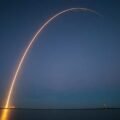Defending Earth from future collisions with asteroids, U.S. space relations with China, and pilot reports involving unidentified aerial phenomena were all among the topics addressed during a University of Virginia live stream event on Tuesday featuring NASA Administrator Bill Nelson.
Hosted by politics professor and director of UVA’s Center for Politics Larry Sabato, the live stream chat session addressed questions about the politics of space in the 21st century. Covering a range of questions about NASA and its current efforts, the session included discussions about NASA’s Double Asteroid Redirection Test (DART) Mission, where the agency plans to demonstrate the first use of a kinetic impactor to attempt to alter the motion of an asteroid in space.
“Way, way out there, we’re going to intercept this asteroid and DART is going to hit it at 15,000 miles an hour,” Nelson said during the live stream. “We’re going to see if we can, ever so slightly, can move its trajectory.”
Currently in its Phase C stage, NASA’s DART mission is being led by NASA’s Solar System Exploration Program at Marshall Space Flight Center for NASA’s Planetary Defense Coordination Office, along with the agency’s Washington-based Science Mission Directorate’s Planetary Science Division.
“Before we leave,” Nelson interjected near the end of the live stream, “I haven’t even talked about the search for extraterrestrial life.”
After briefly discussing NASA’s current Mars mission and its search for evidence of extraterrestrial life on the Red Planet, Nelson shifted the discussion over to Navy pilot encounters with unidentified aerial phenomena, where he referenced hundreds of sightings he says have occurred since the early 2000s.
“Now I know what you’ve seen is what those Navy pilots saw in 2004,” Nelson said during the live stream chat. “And there have been some three hundred sightings since then.”
“I’ve talked to those pilots,” Nelson added, saying that “they know they saw something, and their radars locked on to it. And then all of a sudden it was here on the surface, and then it’s there. And they don’t know what is. And we don’t know what it is.”
Nelson added that he and his administration hope that the unidentified objects reported by military pilots were not advanced aerospace technologies used by countries like China or Russia.
“We hope it’s not an adversary here on Earth that has that kind of technology,” Nelson said.
“But it’s something,” Nelson added. “And so this is a mission that we’re constantly looking [at]. Who is out there? Who are we? How did we get here? How did we become as we are? How did we develop? How did we civilize? And are those same conditions out there in a universe that has billions of other suns in billions of other galaxies?”
“It’s so large I can’t conceive it,” the NASA chief said.
“It was suggested to me by many different people they did want your comment on what you think the fighter pilots saw,” professor Larry Sabato told Nelson. “I think most people saw that 60 Minutes piece, and there were a lot of news pieces about whether or not it was Russia, or China, or perhaps more likely some extraterrestrial intelligent beings.”
When pressed by Sabato about what Nelson personally thought the likeliest explanation for the sightings might be, the NASA chief seemed to imply that extraterrestrial technologies could not be ruled out.
“My personal opinion is that the universe is so big,” Nelson told Sabato, “and now there are even theories that there might be other universes. And if that’s the case, who am I to say that planet Earth is the only location of a life form that is civilized and organized like ours?”
Nelson, who attended the University of Virginia School of Law himself before serving as a U.S. Senator in Florida, was appointed by the Biden Administration to lead NASA in May after having been recognized as the leading space program advocate during his time in Congress.
In June, a report delivered to the Office of the Director of National Intelligence (ODNI) indicated that there were at least 144 known instances logged by sources within the United States Government involving unidentified aerial phenomena. Of these, 80 reports “involved observation with multiple sensors,” and the majority of the reports “described UAP as objects that interrupted pre-planned training or other military activity.”
According to a NASA FAQ page titled “Unidentified Aerial Phenomena (UAPs/UFOs)” published the same day the ODNI report on UAP appeared online, NASA’s official position is that it does not actively collect information on UAP, although some of its publicly available data may be capable of detecting them.
“NASA does not actively search for UAPs,” the FAQ states. “However, through our Earth-observing satellites, NASA collects extensive data about Earth’s atmosphere, often in collaboration with the other space agencies of the world. While these data are not specifically collected to identify UAPs or alien technosignatures, they are publicly available and anyone may use them to search the atmosphere.”
The NASA statement also says that if the agency were to learn about UAPs, “it would open up the door to new science questions to explore.”
“Atmospheric scientists, aerospace experts, and other scientists could all contribute to understanding the nature of the phenomenon,” the statement reads. “Exploring the unknown in space is at the heart of who we are.”
It is unclear whether the three hundred UAP sightings referenced by Nelson on Tuesday include reports that have been collected since the delivery of the June 25, 2021 report to the ODNI, or whether he or his agency had received information from other sources that might account for the figures cited.
The Debrief inquired with NASA seeking clarification about Nelson’s comments but had received no response from the agency as of the time of publication. Any further information the agency provides will be included in an updated future version of this article.
